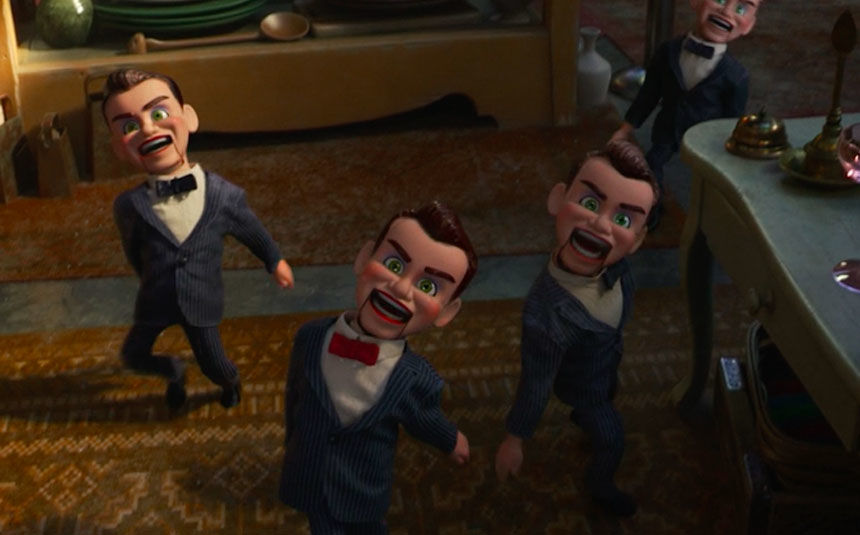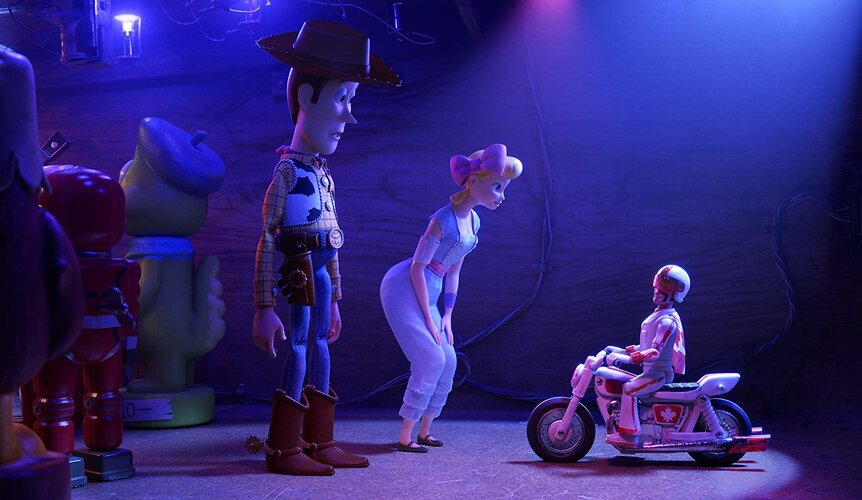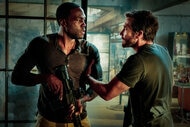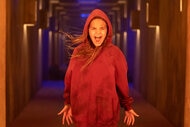Create a free profile to get unlimited access to exclusive videos, sweepstakes, and more!
The joy and horror of imperfection in Toy Story 4

Horror has permeated each installment of the Toy Story franchise — from Sid’s mutant creations to creepy toy collector Al McWhiggin. Almost getting burned alive scores pretty high on the terrifying scale, so it is not surprising that Toy Story 4 also serves up some scares which are usually reserved for more R-rated fare.
For starters? Spooky dolls like Annabelle and Chucky need to move over and make room for the silent Benson ventriloquist dummy gang that answer to each and every one of Gabby Gabby’s (Christina Hendricks) whims in the antique store. However, the truly frightening moments are more existential in nature as a number of deep-rooted insecurities are explored through this Pixar lens.
Spoilers ahead for Toy Story 4.
Gabby Gabby is a retro doll from the 1950s, but unlike Woody (Tom Hanks) her voice box is broken, which has led to a lifetime of bitterness and resentment. Sure, she has sweet vocal tones when she comes alive, but her inability to fulfill her friendship destiny with a human child means she will do whatever it takes to make this happen — and it's a plan she sets into motion when Woody and his still functioning vocals stumble upon her antique abode.Growing up is part of the overall arc of Toy Story 3, which sees Andy no longer needing his childhood things as he heads off to college. In this sequel, these toys have found new life in a different bedroom, but even though Woody looks and sounds as he always has, he is becoming obsolete. While he still has his voice, he is struggling to stay relevant. When he meets Gabby Gabby, he learns he has something she has long desired. It doesn’t matter that she is queen of the antique shop domain with her ventriloquist dummy minions and a pinball machine full of scared toys; she wants more.
Our introduction to Gabby Gabby is a horror tableau in and of itself as the Bensons take her for a morning stroll. Gabby Gabby isn't walking; instead, she is being pushed in a vintage pram doubling as a carriage. The uncanny valley aspect of dolls means they are inherently creepy, and Hendricks' voice is incredibly sweet but her giggle doesn't hide the potential menace that lurks within this pram. There's a reason why horror movies focusing on dolls which come to life are so popular. For every Toy Story that features benign sentient objects, there is an Annabelle or Child’s Play franchise. It is nice to think of your toys having feelings and coming to life until they want to murder you.If there is a reason this introduction to Gabby Gabby all seems straight out of The Twilight Zone, that's because it kind of is. Hendricks' character was partially inspired by the 1963 Twilight Zone episode "Living Doll" featuring Talky Tina, and Toy Story 4 director Josh Cooley mentioned this character alongside Chatty Cathy, Norma Desmond from Sunset Boulevard, and The Godfather as influences in creating this antagonist-turned-sympathetic figure.
Producer Mark Nielsen refers to the Bensons as “by far, some of the creepiest characters we’ve ever created,” in part because the “dummies’ bodies are soft with no structure, so our dummies’ arms just dangle and their legs bend backwards. Throw in their fixed expressions with their wide eyes and big hinged jaws and they’re nightmare material—in the best way possible.” The heads that turn 360 degrees like Linda Blair's Reagan in The Exorcist is high on the list of creepiest moments from this movie. Thankfully, they don't have a set of stairs to spider-walk down.Where Sid deconstructed toys in order to make the most horrifying version, Gabby Gabby wants to rip Woody open so she can become her dream self. She can reapply her painted freckles as much as she wants but freshening up her physical appearance is never going to be enough. Social media isn’t explicitly mentioned in Toy Story 4, but this notion of curating the perfect image matches with the version that platforms such as Instagram allow us to present to the world. Manipulating photographs isn’t unique to the 21st century, but the technology available means we are all able to banish any blemish with the click of a button or swipe of a screen.
Gabby Gabby looks perfect in her yellow polka dot dress and matching ribbons, but she is incredibly lonely. Without her voice, she feels broken. The injustice of it all is too much for her to bear after years of reading the same book about her so-called destiny. She is not alone in feeling incomplete, as Duke Caboom (Keanu Reeves) has deep-rooted insecurities as a result of failing to live up to the abilities of the advert he starred in. Existential dread permeates every corner of this movie as many of the characters question their role in the world.Advertisements sell a version of reality that doesn’t really exist, so while they are meant to accurately show what a toy can do, the result is often lacking. Duke Caboom isn’t trying to take something from another toy in order to feel complete, but his confidence is shaken despite his initial outgoing behavior. Forky (Tony Hale), who is actually made of trash, didn’t come with any kind of expectations — other than being trash — and has become Bonnie’s (Madeleine McGraw) favorite toy despite not coming from a fluorescent-lit store. The charm of Forky isn't that he came in a box from a shelf lined with the same toy; instead, he was made by Bonnie herself. Like all of us, he is unique. Imperfections are part of who we are and it doesn’t matter how many filters or Photoshop apps we use to smooth away lines or blemishes.
Gabby Gabby does get the voice box she has been craving for years; however, she is still discarded by the kid she has been projecting all her hopes and dreams on. Even when you make the ‘perfect’ version of yourself, it might not be enough. At the opposite end of this scale is Forky, who doesn’t want to be considered a toy because he has been designated as trash. Expectations can have a huge impact on how we interact with the world. Meanwhile, Bo Peep (Annie Potts) tapes her broken arm back into place without complaint. She has been on both sides as a lost toy and beloved by children, and she has found balance in her sense of self as a result.Being lost can have many different physical or mental connotations. Anxiety levels are high for many in Toy Story 4 as feelings of inadequacy threaten to overwhelm. Finding your place in the world can be hard, particularly with the pressure we put on ourselves to match an ideal perpetuated by advertising and social media. In the end, Toy Story 4 celebrates the imperfections and reminds us to get out of our own way.






























